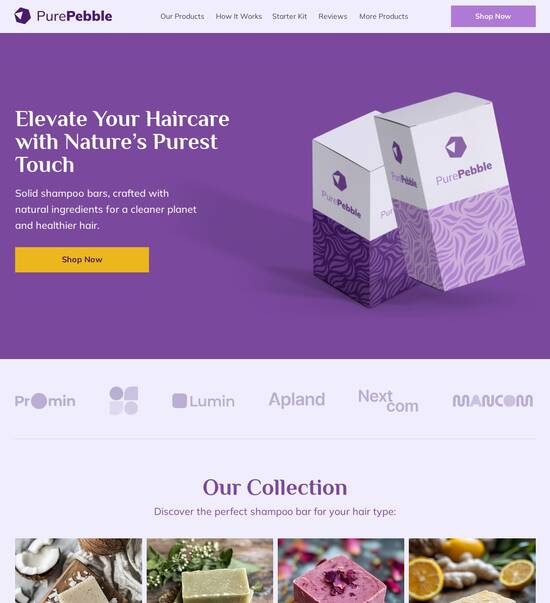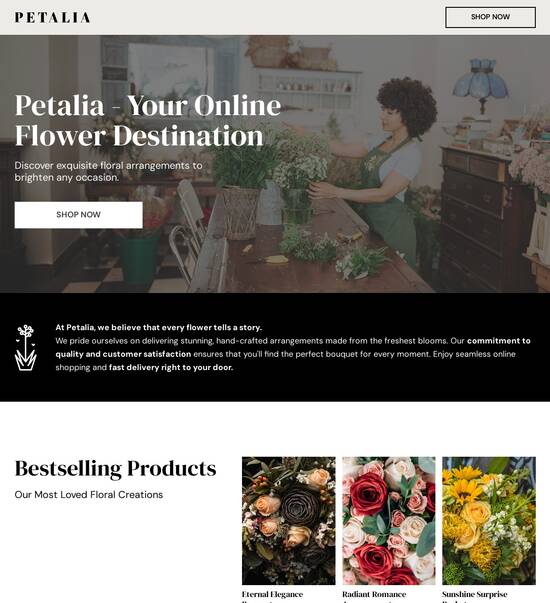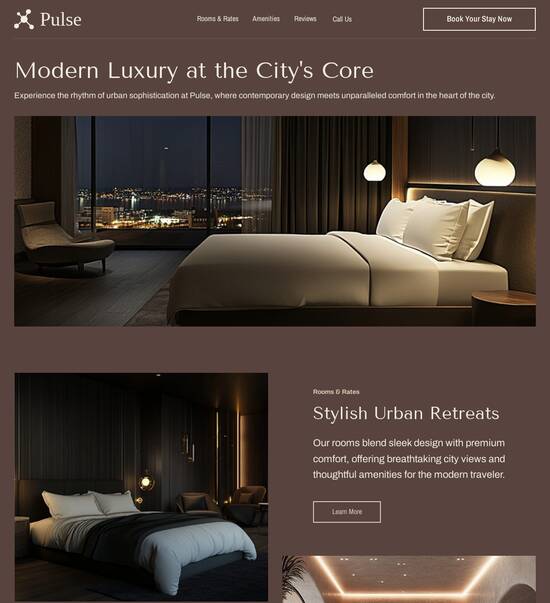
Landing page template for interior design firms
Use TemplateAbout template
Give your interior design firms a boost with our professional landing page templates. Ready to turn visitors into customers?
Recommended templates

Easy to build without coding
With the intuitive drag-and-drop builder, anyone on your team can create high-converting pages without any knowledge of code or design. Make enhancements to your landing page with custom widgets using Javascript, HTML/CSS, or third-party scripts.

Multiple layouts for any industry and goal
Select from 500+ landing page layouts built to boost conversions across industry-specific scenarios. Customize them by adjusting fonts, adding images, and generating on-brand content with the AI assistant. Quickly scale with Instablocks® and Global Blocks that you can save, reuse, and update globally.

Loads fast and looks polished on any device
Every template is responsive, which means they present professionally on any device and load blazingly fast with our Thor Render Engine. You can also power them up with Google AMP technology to deliver an unparalleled mobile experience and drive higher conversions.

Robust analytics & experimentation
Get real-time updates and reporting across all your devices, showing the number of visitors, conversions, cost-per-visitor, and cost-per-lead. Launch AI-powered experiments, run A/B tests, and use heatmaps to analyze user behavior, then optimize your landing page to maximize conversions.







Easy to build without coding
With the intuitive drag-and-drop builder, anyone on your team can create high-converting pages without any knowledge of code or design. Make enhancements to your landing page with custom widgets using Javascript, HTML/CSS, or third-party scripts.
Multiple layouts for any industry and goal
Select from 500+ landing page layouts built to boost conversions across industry-specific scenarios. Customize them by adjusting fonts, adding images, and generating on-brand content with the AI assistant. Quickly scale with Instablocks® and Global Blocks that you can save, reuse, and update globally.
Loads fast and looks polished on any device
Every template is responsive, which means they present professionally on any device and load blazingly fast with our Thor Render Engine.
Robust analytics & experimentation
Get real-time updates and reporting across all your devices, showing the number of visitors, conversions, cost-per-visitor, and cost-per-lead. Launch AI-powered experiments, run A/B tests, and use heatmaps to analyze user behavior, then optimize your landing page to maximize conversions.
All the features you need to build interior design landing page design
Explore more featuresLearn how to build interior landing page
Frequently asked questions about interior design landing page template
Leading the way in building high-performing landing pages





Landing page interior design: Your ultimate how-to guide
Landing page templates specifically designed for interior design firms significantly enhance online presence and conversion rates. Instapage offers powerful tools that streamline the creation of visually appealing and high-converting landing pages tailored to the unique needs of the interior design industry. With a focus on aesthetics and user experience, these templates can drive your marketing campaigns to new heights.
Understanding the importance of landing pages in interior design
A well-optimized landing page serves as a crucial tool for any interior design firm aiming to capture leads and convert visitors. Your landing page must not only represent your brand effectively but also resonate with potential clients’ needs. Here are key elements to consider:
- Visual Appeal: Use high-quality images of your design projects to engage visitors.
- Clear Call-to-Action: Prompt visitors to take action, like scheduling a consultation or signing up for a newsletter.
- Responsive Design: Ensure your landing pages look great on all devices, providing a seamless experience.
Step 1: Choose the right template
Selecting a suitable landing page template is crucial for capturing the essence of your design style. Start by navigating to the library of over 100 high-converting templates on Instapage. Examine templates specifically geared toward service-oriented businesses like yours.
Step 2: Customize your landing page
Your next step is personalizing the chosen template to reflect your firm's branding and unique offerings. Focus on:
- Brand Colors: Incorporate your brand’s color scheme to create a cohesive look.
- Typography: Use fonts that resonate with your design aesthetic while ensuring readability.
- Content: Craft compelling copy that highlights your firm's unique value propositions.
Step 3: Optimize for performance
After customizing, it’s vital to optimize your landing page for high conversion rates. Key aspects include:
- A/B Testing: Experiment with different headlines or images to identify the most effective combinations.
- Load Speed: Ensure that the page loads quickly to minimize visitor drop-off.
- Analytics Integration: Use Instapage’s built-in analytics tools to track user behavior and adjust accordingly.
Creating an effective landing page template for interior design firms is a multi-step process that combines thoughtful design and strategic optimization. By focusing on visual appeal, customization, and performance, you can significantly enhance your online marketing efforts.
Ready to elevate your interior design firm’s online presence? Start using Instapage today to create stunning landing pages that convert visitors into clients.
Landing page template for interior design firms
Understanding the need for specialized landing page templates in interior design
Interior design firms operate in a unique space where aesthetics and functionality converge to create inviting environments. To truly resonate with potential clients, these firms require a landing page that reflects their artistic vision while also providing clear information about their services. The right landing page template can not only enhance a firm’s online presence but also streamline the process of converting visitors into clients.
The unique nature of interior design firms
A. Defining interior design: Differentiating between types (e.g., residential vs. commercial) involves recognizing that each type caters to different client needs and aesthetics. Residential design typically focuses on comfort and personalization, while commercial design emphasizes functionality and branding. Understanding these distinctions helps firms present tailored services through their landing pages.
B. The importance of visual storytelling in the design field is paramount. Interior designers thrive on creating spaces that tell a story; thus, their web presence should similarly narrate their design philosophy and past projects. An effective landing page template should incorporate storytelling elements that engage potential clients.
C. How consumers search for and assess interior design services online has evolved with digital tools. Prospective clients often browse multiple platforms, compare portfolios and read reviews to gauge a designer’s capability. A well-designed landing page can meet these needs by showcasing the firm’s best projects and testimonials.
Characteristics of effective landing pages for interior designers
A. Visual appeal is critical; utilizing high-quality images and aesthetics ensures that the landing page reflects the designer's skill set and professionalism. A visually rich page can make a lasting impression on visitors and promote deeper engagement.
B. Navigation structure plays a key role in ensuring users can easily find the information they need. Intuitive user journeys reduce frustration and enhance user experience, encouraging visitors to stay longer and explore more.
C. Content relevance involves tailoring messaging to target audiences. Highlighting specific areas of expertise and including relevant language helps to customize the user experience and optimize conversion rates.
D. Captivating headlines and subheadings serve to draw in visitors while clearly communicating value. A strong headline can make the difference between a user clicking away or delving deeper into your offerings.
Exploring the power of dedicated templates
The anatomy of an ideal interior design landing page template consists of key components that facilitate effective communication with potential clients. A well-structured landing page includes a header with branding elements, eye-catching hero images or sliders, and dedicated sections for project showcases, client testimonials, and case studies that lend credibility.
Essential web elements to include feature contact forms for lead capture, social media integration buttons for sharing, newsletter signup forms to keep clients engaged, and callout areas for special offers or promotions that attract immediate interest.
Tailored website templates for increased effectiveness
Customization options for unique branding are crucial. Colors and fonts should mirror the firm’s identity, helping to create a consistent brand image that resonates with visitors. Layout variations allow firms to showcase diverse project collections effectively, adapting their presentations based on targeted audience segments.
Resizing for mobile optimization is another integral aspect, as more clients are browsing on mobile devices. Importance of mobile-friendly designs cannot be overstated, and utilizing techniques for maintaining quality visuals on smaller screens ensures a seamless experience across all platforms.
Functional capabilities of templates for interior design firms
Streamlined workflow with HTML templates can significantly enhance a firm's productivity. Benefits of utilizing pre-designed HTML templates include speed; they allow for faster deployment of web pages, ensuring that firms can react quickly to market changes while maintaining a consistent brand image across various channels.
Editable elements for personalization include features such as drag-and-drop functionality, which permits users to easily arrange components according to their vision, and modifiable code fields for advanced users who want to customize elements further.
Responsive design: how templates adapt to user needs
Understanding the mechanics of responsive web design is essential for modern interior design firms. CSS media queries and fluid grids are techniques that allow layouts to adjust based on screen size, ensuring a consistent and user-friendly experience for both desktop and mobile users.
Real-life examples of responsive interior design websites provide insights into successful transitions from desktop to mobile. Firms that have embraced responsive design are often able to boost their web traffic and consequently convert more visitors into clients, underlining the importance of adaptable technologies.
Enhancing user experience through advanced features
Integration with marketing tools and platforms allows interior design firms to optimize their client acquisition processes. Utilizing CRM and email marketing integrations helps in lead management, ensuring that interested visitors are nurtured through personalized follow-ups.
Tracking and A/B testing features facilitate continuous improvement. Understanding user behavior through analytics provides vital data on what works and what doesn’t. Experimenting with different layouts and content types enables firms to refine their approach and enhance engagement.
Inspiration sources: creating visually striking pages
Drawing design ideas from architectural trends can breathe new life into a landing page. By staying updated with the latest styles—be it minimalism or maximalism—firms can create pages that are not only visually appealing but also relevant to current market demands.
The role of nature and light in interior design brings unique dynamics to the storytelling aspect of landing pages. This can be further enhanced by incorporating elements of color psychology, which informs how color choices impact emotion and perception in design.
Optimizing performance with built-in features
Understanding SEO-friendly structures within templates is vital for boosting search visibility. Important components include utilizing header tags and well-crafted meta descriptions that encapsulate page content while aligning with search queries related to interior design.
Amplifying local SEO for interior design firms involves integrating Google My Business information into landing pages. By utilizing local keywords effectively, firms can attract more nearby clients who are searching for relevant services.
The impact of fast load times on visitor retention
Analyzing speed optimization techniques is crucial for retaining visitors. Fast loading pages create a smooth and enjoyable user experience. For example, minimizing image sizes without sacrificing quality helps in achieving this goal.
Utilizing content delivery networks (CDNs) can also significantly improve load times. By distributing content across multiple servers, CDNs reduce the amount of time it takes to load a page, leading to higher retention and reduced bounce rates.
Future-proofing your landing page strategies
Keeping up with design trends and technology is essential for interior design firms to remain competitive. The evolution of interior design marketing in the digital age presents opportunities for firms to leverage innovative tools and strategies that align with shifting consumer expectations.
Anticipating user trends will influence what clients may want in the future. For example, increased demand for virtual consultations and interactive design solutions may shape how landing pages are constructed moving forward.
Crafting an engaging narrative through templates
Creating compelling stories with image and text enables interior design firms to build emotional connections with potential clients. Utilizing project stories that follow a client journey from concept to completion provides valuable insights into the firm’s process.
Merging visuals with textual content leads to a more holistic user experience. This integration not only showcases the designer's skills but also engages users on a deeper level, allowing them to envision their own spaces.
Ready to skyrocket conversions?
Supercharge your ad campaigns with high-performing landing pages
Get started














